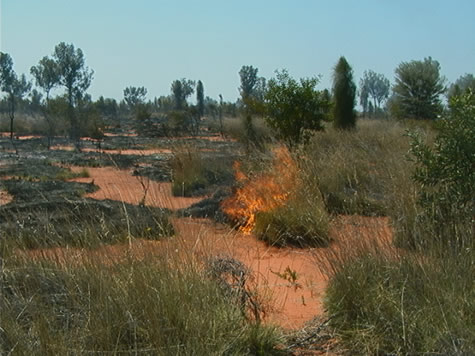2001 September 17. Monday. North of Ace Bore.
The heart of the fire we saw today was basically a bare piece of black and red ground. The action was at the edges of a circle surrounding this. The burning area itself was but a yard or two in width, and travelling gradually outward. I skipped through the ‘frontier’ of the burning, onto the blackened ground, and felt the heat of the sand – it was very similar to the temperature of the sand we had sat upon at billy tea break. This means the fire must be travelling quickly, to not have time to heat the ground as it passes across it.

Although a light but steady wind was present, it did little to blow the fire in any particular direction, so that the only things keeping it from burning outward in a geometric circle were fire-breaks such as the track we followed, and variation in the make up of the groundcover - especially underneath desert oaks, the tallest trees to be found in this area. At some points, the fire did manage to cross the track, as it is rarely used and very overgrown. Here we saw an hourglass shape as the burning ‘funneled’ through the gap.
If a fire began in an evenly vegetated area, where there was no road to distort it, and burned out a circle, we could calculate the area which would be burnt after a given amount of time, by observing how fast the fire travels, and using the formula for the area of a circle: πR2, where R is the radius, or half of the distance across the circle.
If a fire circle with a diameter of eighteen metres travelled at six metres per minute in every direction, work out the following:
* The area of the initial burnt section
* How large the circumference – distance around the fire - would be.
* The diameter of the fire circle after five minutes burning.
* The area of the circle after five, fifteen, and thirty minutes burning.
* How long would it take for the fire to cover one square kilometre.